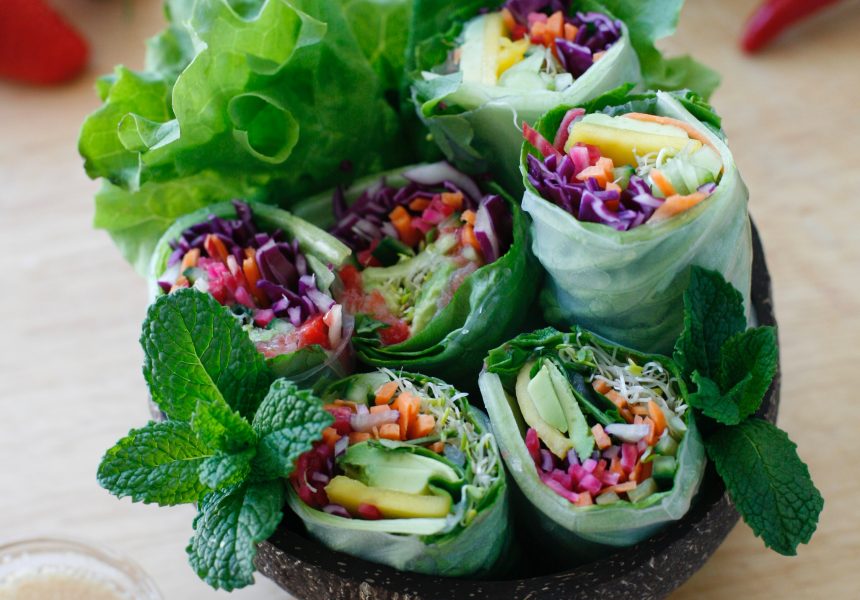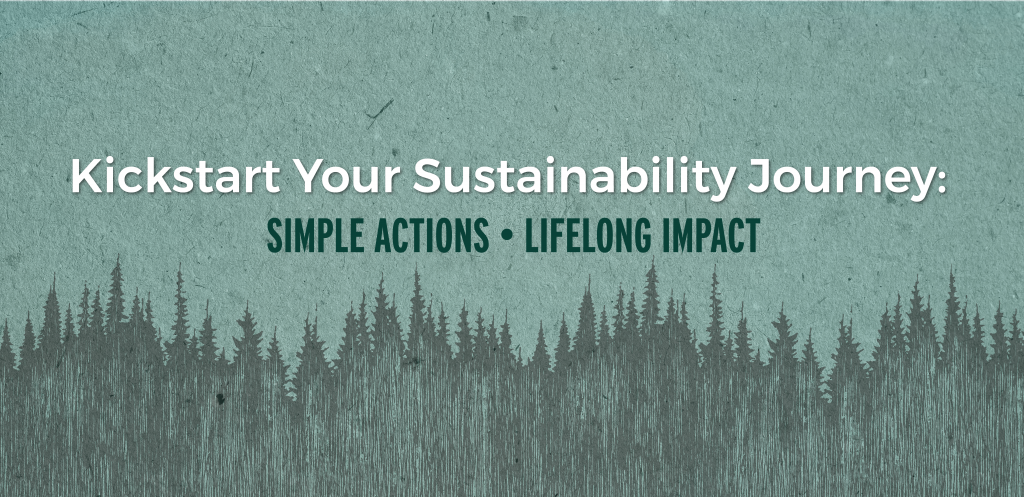(Note: this post was originally published in February 2022, but I’ve given it a bit of a refresh for this years Super Bowl game and party)
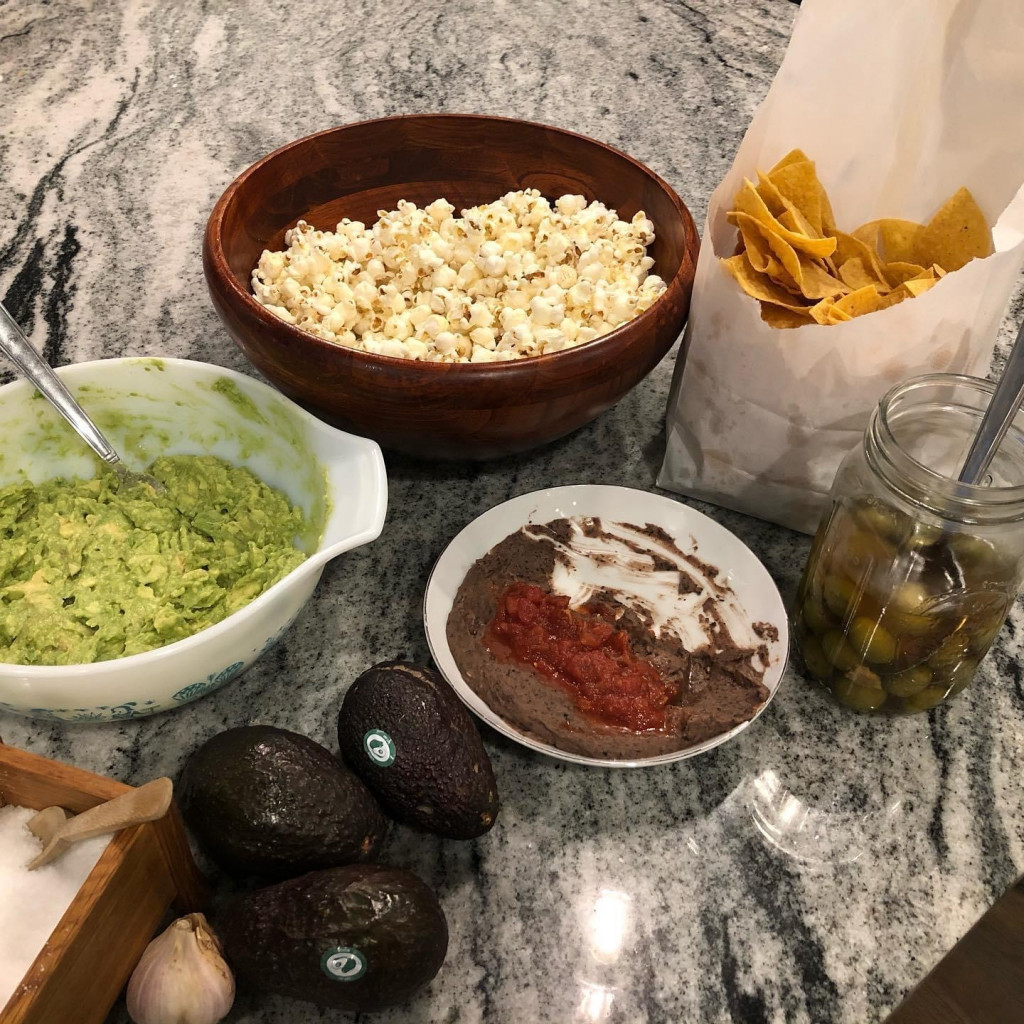
In general, here are my strategies for picking the best (and lowest waste) super bowl (or, erm…. Saturday afternoon or Friday night movie night) snacks:
- Choose homemade snacks – homemade is almost always going to be lower waste than the pre-made alternative (in fact, if you can think of a single example that breaks this rule, tell me in the comments and I’ll figure out some sort of prize!). Think about a bag of potatoes vs frozen tater tots, potato skins or French fries and “naked” avocados, garlic and tomatoes vs the plastic tub of remade guacamole
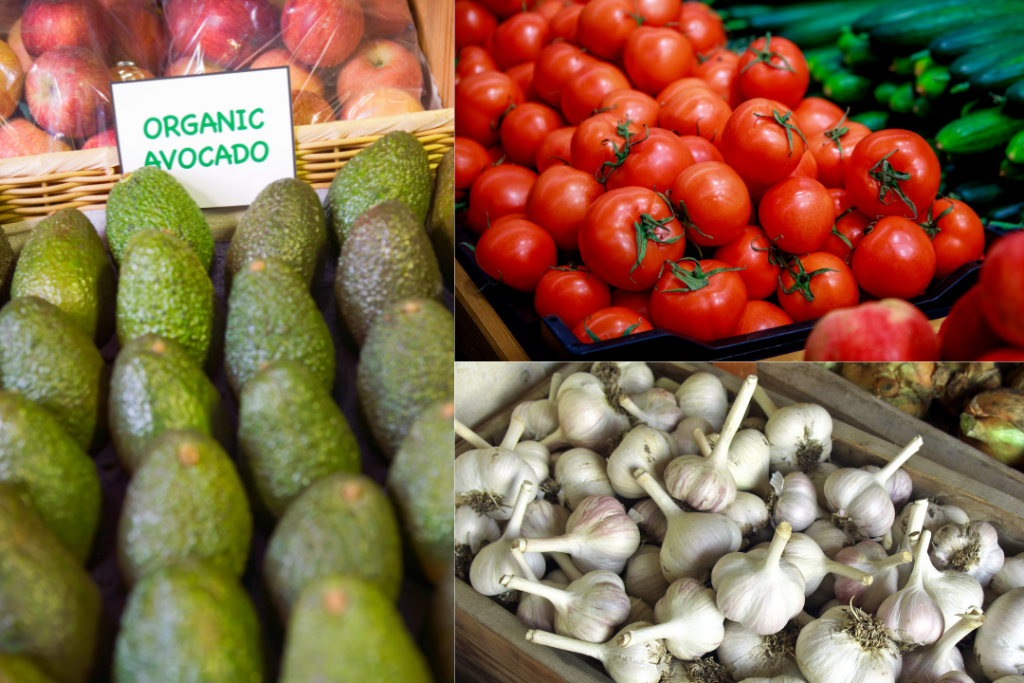
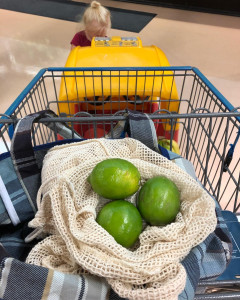
- Look for “naked” ingredients – meaning those you can buy without any packaging. Vegetables and fruits are perfect examples of this. Look for them in bulk bins and DON’T use the plastic bag. You can either bring your own produce bag (see my recommendations here if you want to purchase a few) or just throw them into your cart without a bag… trust me, the cashier will be able to ring them up for you like this just fine!
- Buy local – this is a great opportunity to support your favorite bakery, local farmer, cheese shop, or neighborhood restaurant. Lots of times, businesses like this would be happy to cater your party, make a cheese tray (hint, hint, the Rockford Cheese Shop) or create a large quantity order, but you’d better call ahead… the sooner the better!

 Buy in recyclable packaging – remember that metal and glass can be recycled endlessly (meaning over and over and over and over and… you get the idea), paper 5-7 times, and plastic only 2-3 times. I use this order to guide my packaging selection when I have choices.
Buy in recyclable packaging – remember that metal and glass can be recycled endlessly (meaning over and over and over and over and… you get the idea), paper 5-7 times, and plastic only 2-3 times. I use this order to guide my packaging selection when I have choices.
- Buy in bulk – More food in the same container slightly reduces the packaging:food ratio. This is my last ditch effort to make a more sustainable choice, but this ONLY WORKS if you EAT ALL THE FOOD! Buying more than you eat (to save on packaging) and then throwing away the excess food COMPLETELY defeats the purpose!
OK, on to our favorite snacks! Here they are, in no particular order…
- Guacamole (my favorite) – we’ve already talked about buying the

avocados, garlic, and tomatoes “naked” from the grocery store. Bonus points if you’ve grown any of these ingredients yourself. I go the extra mile and walk to the little Mexican restaurant down the road from my house and buy fresh tortilla chips in a paper bag… they’re SO delicious!
- Kale Chips (my oldest daughter’s favorite) – we’re still getting kale from our winter CSA farm share, so February is the perfect time for kale chips! We use this recipe. Even if you can’t buy it from a local farmer right now, kale is one of those vegetables you can usually find “naked” in the grocery store.

- Popcorn (Robbie’s favorite) – this simple snack is our go to for almost any lazy time around the house. Friday night movie night… is better with popcorn! Thursday night dinner when everyone is too exhausted to cook (or eat a real meal)… popcorn! I make it on the stove and don’t follow a recipe, but this one is pretty close to my routine if you’ve never cooked popcorn before. We buy our popcorn kernels in bulk (25 pound paper bag), but you can usually find kernels in glass jars in the grocery store. I use coconut oil, again purchased in a glass jar, and season with sea salt.
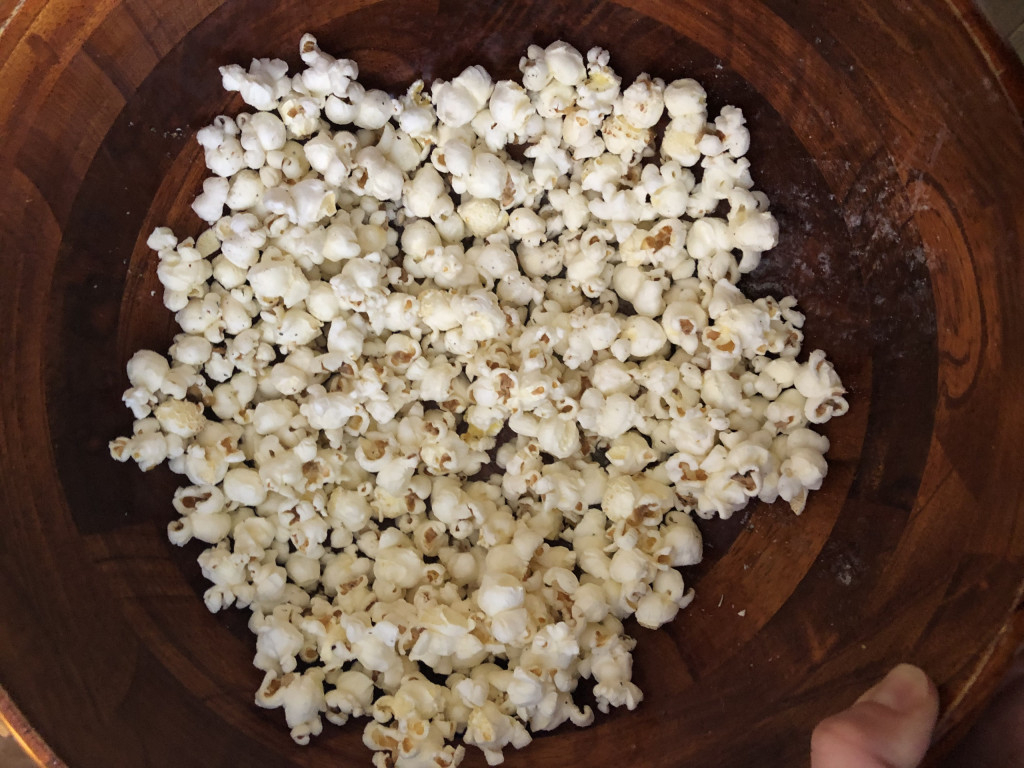
- Bean Dip (my youngest daughter’s favorite) – we nearly always have a batch of cooked black beans in our house (my favorite recipe is from Smitten Kitchen, in her first cookbook The Smitten Kitchen Cookbook, but you can also find the recipe online here) so we can easily whip up a dip with beans + cheddar cheese + sour cream + salsa. I can’t tell you the exact amounts of the ingredients, in part because Robbie always makes this dip and in part because he doesn’t measure, so you’ll have to experiment to find your favorite combo. Again, we eat this with chips from our favorite local restaurant. We buy the beans in bulk (25 pound paper bag) and have a bunch of frozen homemade garden salsa from last summer (but you could buy this in glass), but the cheese and sour cream usually come in plastic.
- 2024 UPDATE: “WEIRD FRUIT” – what?!? what is weird fruit, Erin? This has become the most asked for football snack from both my kiddos. They love to go to the grocery store with me and pick out the most weird looking fruits they can find. Dragon fruit, Buddha’s hand, star fruit… that’s pretty much all we can get at our small town grocery store, but they LOVE this tradition, cutting up and arranging these fruits alongside the more traditional favorites (like cherries, blueberries, and strawberries) for a creative (and lower waste) fruit plate.
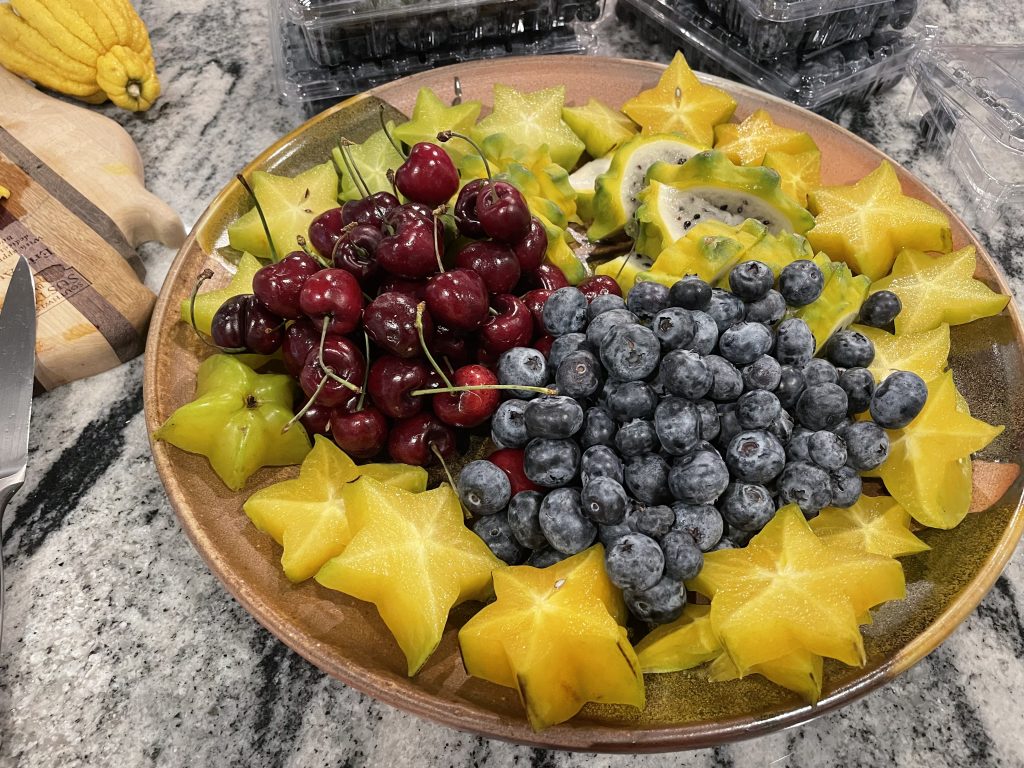
Please add your favorite waste-free, low waste, local or sustainable snack suggestions in the comments!!
]]>There’s a “usual suspects” list of must-see Chicago attractions that get thrown around quite a bit. Whether it’s the Bean, Wrigley Field, Navy Pier, or any number of obligatory things to do while you’re in the Windy City. Your mileage might vary on these endeavors, but Chicago is also becoming a destination for travelers who want to “live like a local.” The stellar food, nightlife, and music scenes are becoming major draws of Chicago. One thing that doesn’t get talked about enough is Chicago as an eco-friendly travel destination.
While it may resemble a concrete jungle as much as any urban metropolis, Chicago has made significant strides in recent years toward becoming an eco-friendly city. City officials have been prioritizing sustainability and environmental initiatives for decades, and you’ll find that an eco-friendly trip to Chicago is very doable.
The biggest thing that Chicago has going for it is its extensive public transportation network. The famous “L” train system serves most parts of the city, and bus routes cover almost the entire city. If the weather is great (big if), Chicago is also very bike-friendly. Chicago’s restaurant scene has fully embraced vegan food and sustainability efforts, so it’s easy to find a plant-based meal in just about every neighborhood. There are also plenty of environmentally-conscious activities and attractions to visit during your trip.
One of the best ways to reduce carbon emissions is to get around on foot or on a bike. If you’ll be propelling yourself around the city, you won’t want to have to lug your bags around all day. Luckily, it’s easy to find convenient luggage storage in Chicago, where you can drop the bags off while you explore the best of the Windy City’s eco-friendly offerings.
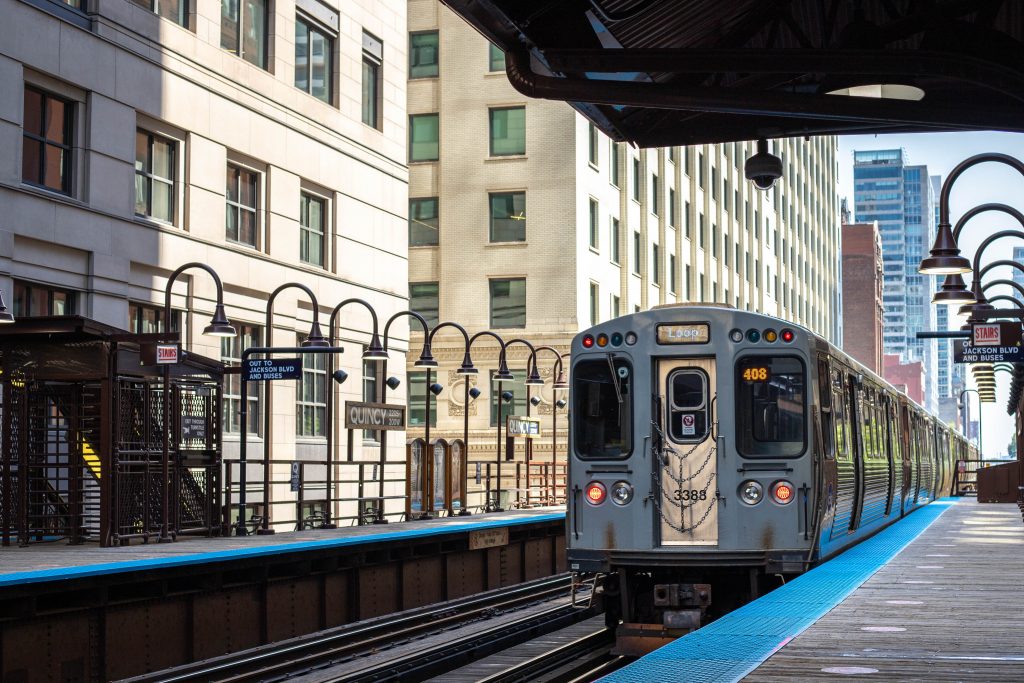
Best ways to get around Chicago
While Chicago is a fairly drivable city compared to New York or Los Angeles, there are plenty of sustainable ways to navigate the city. Here are a few:
Public transportation
Chicago has one of the most extensive public transportation systems in the country. Operated by the Chicago Transit Authority (CTA), there are train lines and bus routes that cover almost the entire city’s geographical footprint.
Most of the popular tourist and business districts are directly served by the “L” train system, which is all routed through “the loop” downtown. CTA bus routes cover the rest of the city and are a very affordable way to get around.
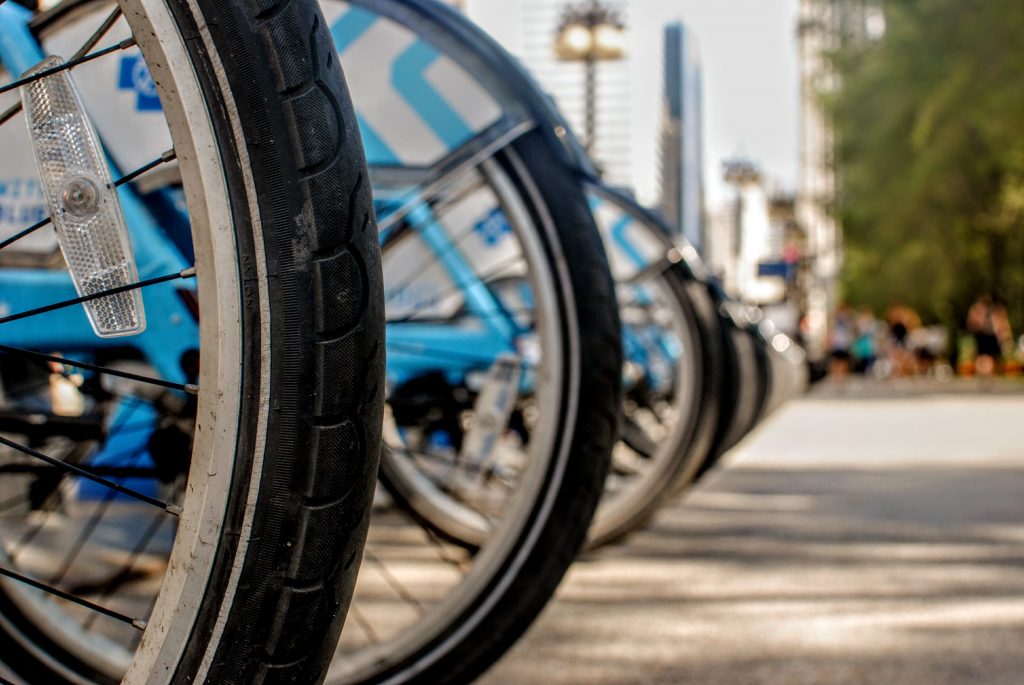
Cycling
Chicago is (almost to a fault) very flat, making it an easy city to navigate on two wheels. In recent years, Chicago has developed a robust cycling infrastructure of designated bike lanes and trails throughout the city.
Divvy, Chicago’s bike-sharing program, is an extremely popular method of transport. During the summer, you can’t miss the thousands of blue bikes being pedaled all over town. This is a great way to get around quickly and conveniently while limiting emissions.
Walking
Chicago’s neighborhoods are pedestrian-friendly and easy to navigate, and it’s generally the quickest way to get around buzzy tourist hotspots and popular nightlife destinations. Depending on your itinerary, you should be able to take the train or a bus to most places and cover the rest of your trip on foot.
Electric scooters
Electric scooters have become VERY popular in Chicago as an eco-friendly mode of transportation. Lime is the most popular service where you can rent an e-scooter to get to and from popular brunch spots and explore neighborhoods.
Vegan restaurants and bars
The windy city may be primarily associated with hot dogs and herculean portions of pizza, but Chicago has a solid vegan restaurant scene. Eating an entirely plant-based diet is one of the best ways to reduce your carbon footprint and minimize animal cruelty. Here are a few notable options for eating vegan while you’re in town:
The Chicago Diner
A beloved institution, The Chicago Diner has been serving up vegan versions of diner classics since 1983. From classic burgers (that you can’t tell are vegan) to hearty brunch scrambles, this menu offers familiar favorites without the guilt.
Handlebar
This laid-back hipster hangout in Wicker Park offers an extensive menu of vegan comfort food. Their seitan wings and vegan mac ‘n’ cheese are both famous among locals, and this cozy spot is an awesome place to have a few drinks as well. During the summer, their back patio is one of the hottest tables in town.
Demera Ethiopian Restaurant
While not exclusively vegan, Uptown’s Demera offers a wide range of vegan-friendly options that showcase the incredible flavors of Ethiopian cuisine. This authentic neighborhood spot features lentil stews, vegetable curries, and injera (fermented flatbread), all of which fit into a plant-based diet.
Bad Hunter
Located in the incredibly lively West Loop neighborhood, Bad Hunter has a vegetable-based menu of inventive modern dishes. The menu isn’t entirely vegan, but there are plenty of options, and they’re known for delicious craft cocktails and natural wine.
Sustainable activities in Chicago
With a stunning lakefront and plenty of parks, there are plenty of ec-friendly things to do during your trip to Chicago. You just have to know where to look!
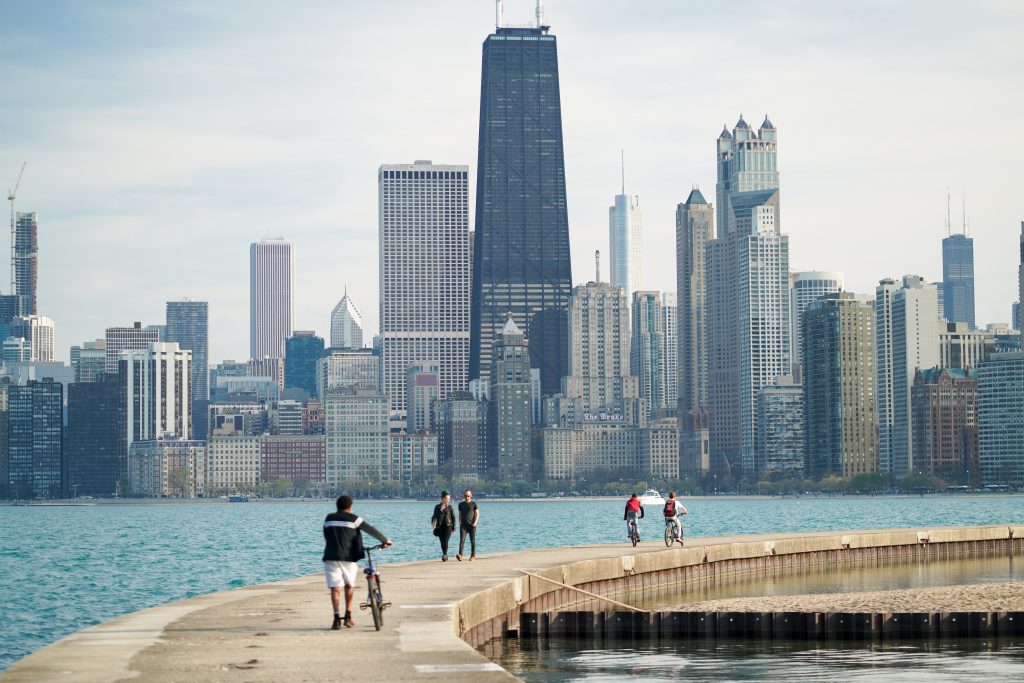
Explore the city by bike
Chicago’s incredible lakefront trail offers amazing views of the skyline along with beautiful Lake Michigan. If you want to see the whole lakefront, you can pedal your way up and down in less than an hour. There is also the 606 trail that runs through uber-trendy neighborhoods like Wicker Park and Logan Square.
Garfield Park Conservatory
Located on the city’s West Side, the Garfield Park Conservatory is one of the most underrated attractions in the city. The Conservatory’s greenhouses are filled to the brim with lush greenery and exotic plants from around the world. There are various themed gardens and a serene atmosphere to enjoy. During the winter, the humid greenhouses will bring you back to life!
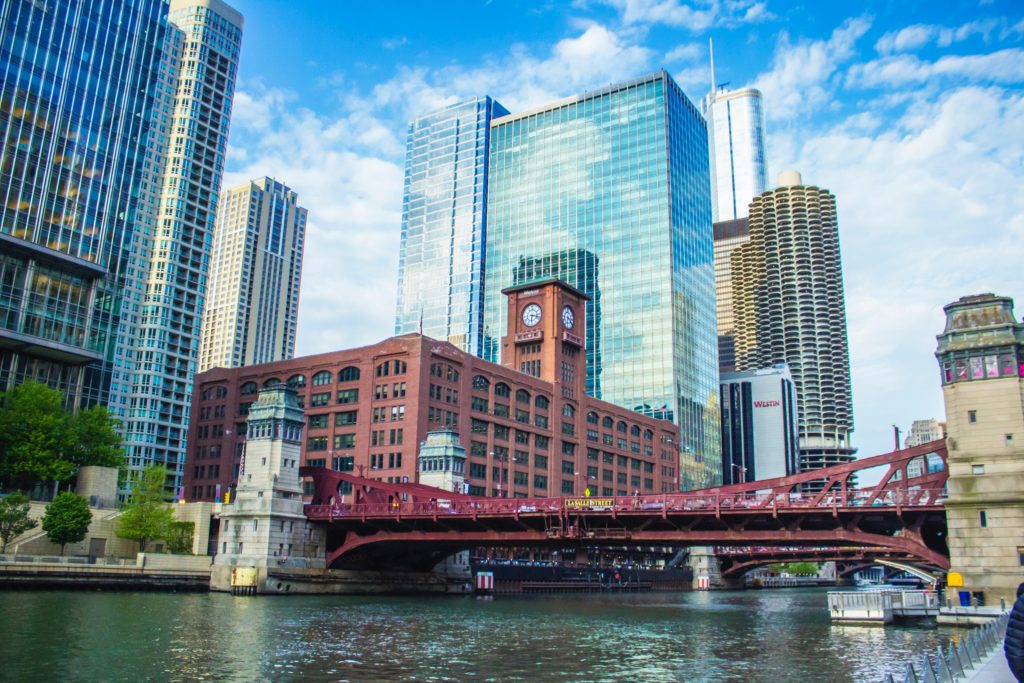
Take a kayak tour instead of a boat tour
The Chicago Architecture Tour is one of the obligatory tourist attractions that come highly recommended. While it’s a solid activity, a greener option would be renting a kayak and exploring the Chicago River without a carbon footprint.
Support local farmers’ markets
Many of Chicago’s neighborhoods host a farmers’ market on weekends. If you want to stock up on local goods and buy supplies for a picnic, head to popular pop-ups like the Green City Market or Logan Square Farmers Market. Even if you don’t buy anything, the people-watching is too good to pass up.
This post was written in collaboration with Bounce luggage storage.
Like this content? Want to see more guest posts? Please drop a note in the comments to recommend new topics or contributors we should be collaborating with.
]]>Most of us firmly believe that one is “better” than the other, but there’s a really interesting debate about the sustainability aspects of this tradition. Here are a few pros and cons to consider when choosing the type of tree you use to celebrate the holidays.

Natural Trees
PROS
- The trees provide many benefits to the environment as they grow, cleaning the air and providing watersheds and habitats for wildlife.
- They are a renewable resource and replanted after being cut.
- They grow best on rolling hills that are often unsuitable for other crops.
- When you buy a tree from a local farmer, you’re supporting the people who live in your community.
- Trees are biodegradable and can be composted, mulched, or burned.
- The British Carbon trust estimates the average carbon footprint of a natural tree is 3.5kg of CO2 when composted, mulched or burned.
CONS
- Buying a tree every year can get very expensive. According to Consumer Reports, the average cost of a natural Christmas tree in 2020 was $81.
- Not everyone has access to local Christmas trees and transportation contributes to the environmental impact of your tree. If you drive more than 10 miles to get your tree, it might be more environmentally friendly to purchase an artificial one.
- Not everyone has access to tree recycling programs. In the UK, an estimated 7 million Christmas trees are landfilled each year.
- The British Carbon trust estimates the average carbon footprint of a natural tree is 16kg of CO2 when composted, mulched or burned.

Artificial Trees
PROS
- The average artificial tree costs $107, making it the economical choice in the long run.
- Caring for your tree and extending its use beyond the average seven years will certainly reduce the environmental impact.
- Reselling, gifting, or donating your tree when you’re done with it will help extend the life.
- If you use your tree for 12 years or more, you might actually have less of a carbon footprint than a natural tree.
CONS
- Most of the artificial trees on the market are made of PVC and steel in China and shipped to the United States.
- Artificial trees are used for an average of 7 years before it is disposed of. If a tree is displayed for 1 month/year, it will have served as a Christmas tree a total of 7 months.
- Most artificial trees cannot be recycled at the end of their life.
- The British Carbon trust estimates the average carbon footprint of an artificial tree at 40kg.
My vote? Team Natural!
My family sits squarely on Team Natural. In fact, we choose to hunt for our Christmas tree in the National Forest each year and it’s one of my favorite family holiday traditions! We love the adventure of wandering through the wild forest, foraging for the “perfect” Christmas tree.
Did you know you can harvest a Christmas tree from the National Forest? You can! And in Michigan, the permit is only $5. Read more about my tips and recommendations for a successful Christmas tree hunt in the national forest here, in this updated blog post.

Let’s Recap
If you’re going to buy a natural tree, buy local from a tree farm or retailer (preferably less than 10 miles from your home) and don’t throw your tree in the trash after the holiday.
Lots of municipalities have specific days for curbside recycling of Christmas trees. Alternatively, you can put it in your yard waste container, drop it off at a local recycling center, or let it naturally biodegrade on your own property if you have the space.
Birds and small mammals love the extra shelter and you’ll be shocked how quickly the tree decomposes. Usually, your county/city will share this information right after Christmas. Please feel free to share a link to your county/city tree recycling program in the comments. I’m sure your co-workers will appreciate it!
If you’re going to buy an artificial tree, buy the most durable one you can find (look for warranties) and keep it as long as possible.
For all this debate, it’s worth maintaining the perspective that no matter which you choose, your tree has a climate impact equivalent to driving roughly between 10-20 miles. So, bike to work a few days a year, and you’ve already offset your tree, no matter which type it is.
What about you?
Are you on Team Natural? Feel free to share your favorite local tree farms in the comments.
Are you on Team Artificial? Who’s had their artificial tree the longest? Anyone over 10 years? 20 years? What’s the sturdiest model available?
Here are links to my sources if you’re interested in digging deeper.
https://www.sightline.org/2015/12/21/your-christmas-trees-carbon-footprint/
https://www.nytimes.com/2018/11/26/business/energy-environment/fake-christmas-tree-vs-real-tree.html
https://www.independent.co.uk/environment/christmas-trees-recycling-environment-sustainability-plastic-a8705081.html
https://www.carbontrust.com/news/2013/01/christmas-tree-disposal-advice/
https://www.in.gov/dnr/forestry/7561.htm?fbclid=IwAR3PlYxqOFDnWILG7ej8_BPRSsCPhO2LjGq2L9dZ3gXqwh7NKeu55LX53eY
https://www.thinkstep.com/content/study-comparative-life-cycle-assessment-artificial-and-natural-christmas-tree
]]>
A few years ago, I bought a bunch of flannel fabric in adorable holiday prints and sewed up a whole pile of reusable gift bags. This year, I’m honored that my tutorial was selected to be included in the winter edition of the Simple Living Collection!
The Simple Living Collection is a digital bundle of resources to help you settle into a slow and intentional life, reconnecting with each other and nature, and embracing this magical wintery time of rest. There are 70+ tutorials, recipes, ebooks, stories and other activities from more than 50 contributors, just like me. It’s on sale for $25 until Monday, December 13th. Available for immediate download, the PDF is yours to keep and revisit year after year for inspiration. If you’re interested, you can buy your copy here!
The Collection is divided into seven different sections to help families build their own slow-living resource binder. Grow, Raise, Create, Nourish, Healthy Home, Wildcraft, and Family. I’m so excited to share a few of my favorites from each section with you!

This is my favorite section, full of seasonal and holiday crafts! Simple ones that will make for a joyful hour with the kiddos and longer projects to sink deeply into on a slow and quiet morning by the fire. My favorites include:
- Salt dough ornaments from Heather Turner @thehomespun.mom
- Felted fingerless gloves from Emma-Lisa McGee @ourhomeonthehill
- Evergreen dish tutorial from Tara Rondinelli @littlepinelearners
- Natural winter village from Naomi Noyes @ninos.and.nature
- Winter solstice garland from Angela Ruggles @the.nature.atelier
- and MY reusable gift bags!

These three sections combine so nicely to help you feed your family with simple healthy food (hello, micro greens! and I think the extracts make perfect gifts) and sweet treats for your holiday special occasions. My favorites include:
- Homemade extracts from Christy Rucker @christyrucker
- Skillet star bread from Cassandra Evans @northwoodsfolk
- Cardamom sourdough cinnamon rolls from Tess Czulinski @naturally_tess_
- Microgreens made easy from Joey Hodlmair @destinationmommy
- Shiitake log tutorial from Roxanne Ahern @happyholistichomestead
- Winter chicken care from Ashley Comer @slowlivinghomestead

Last, but certainly not least, here are a few of my favorites from the healthy home, family, and wildcraft sections of the Collection. The family section, especially, has lots of fun stories, games, and activities to play with your children, grandchildren, nieces and nephews, or visiting friends with kids during this winter season. There’s plenty here to keep you all entertained!
- Wool dryer balls from Harmonie O’Loughlin @florasfeastbotanicals
- Seasonal simmer pot recipe from Kaila Addis @wildmamarising.ct
- Sustainable gift wrapping (no sewing required!) from Ashley Comer @slowlivinghomestead
- Winter Solstice Guide from Jessie Lehson @wineberryadventurescouts
- Birdseed ornaments from Mari Johnson @bellamartinelli
- Winter puppets from Millie Hernandez @forest.roads
These are only a sampling of the phenomenal work put in by all of the wonderful contributors in this community effort! I’m so excited to be a part of it. The Collection is on sale for $25 until Monday, December 13th and you can get your copy here!
]]>
There’s one thing I know for certain: we can’t consume our way to a life that doesn’t destroy the planet, so you won’t find a quick list of things to buy in any of my blog posts. That means my top five is a list of simple ways to change your mindset and habits that will help you tread lightly on the planet. So… after a couple weeks of thoughtful reflection, here’s my list of five great sustainability {mindset} swaps (in order of importance, according to me, which means they’re based on science and anecdotal lessons learned from friends and clients):
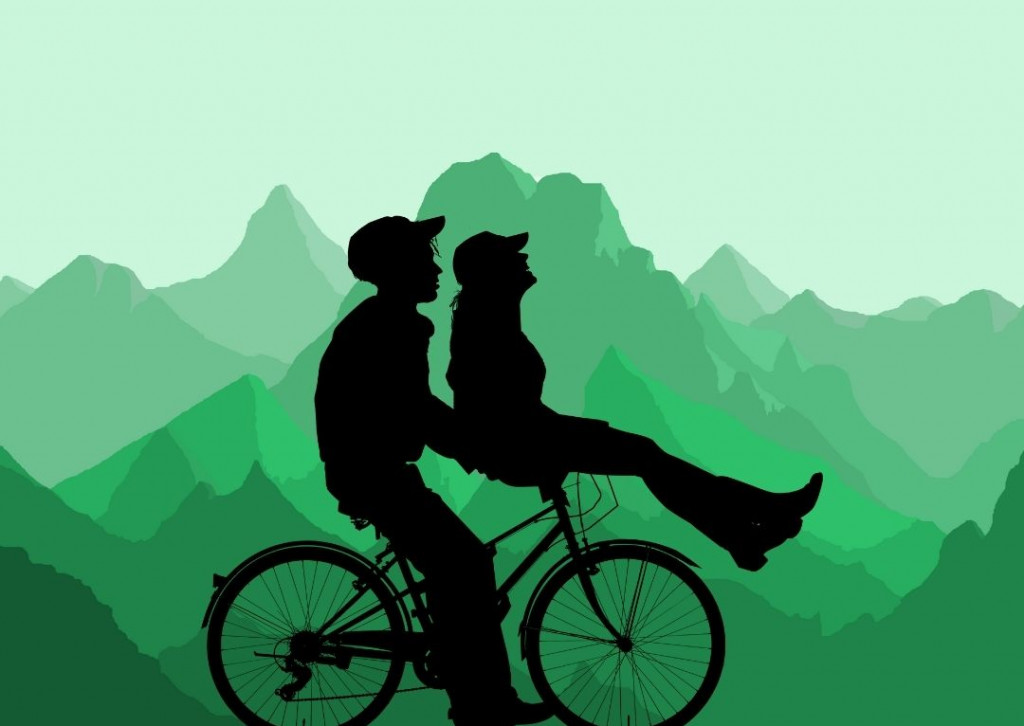
1. Drive less, walk or bike more. Take a good hard look at your car before you drive somewhere. Can you walk your kids to school instead of driving them? Can you walk or bike to the grocery store? If your gut reflex is no, I encourage you to think a little more creatively… a backpack is great for carrying groceries home on foot and a bike trailer is your friend when you’re biking. These activities will reduce your impact on the earth (mostly carbon emissions, which are causing global warming) AND make you healthier! Sure, it might take you a little longer than driving, but can you eliminate time at the gym because you’re so much more active during the day? This is an important swap in your daily life and especially important when you’re making big life decisions, like taking a new job or buying a new house. In those big moments, consider driving vs walking/biking as an important factor in your decision.
2. Keep looking at your car and calculate your miles per gallon (mpg) efficiency, if you don’t already know it. This tells you how efficient your engine is at driving you where you need to go per gallon of gas it burns. You want this number to be as high as possible. For example, the average truck, minivan or SUV gets about 17.5 miles per gallon of gas. An average car gets closer to 25 mpg and a motorcycle gets around 45 mpg (the source for all of these numbers is here). When you’re ready to replace your car, buy the most efficient car you can afford (that’s one with the highest mpg rating). I’m a huge fan of electric vehicles (EVs) and purchased a Tesla Model S in February 2020. You can read about my experience in blogs here and here. If you want to talk more about EVs, please leave your questions and comments below!
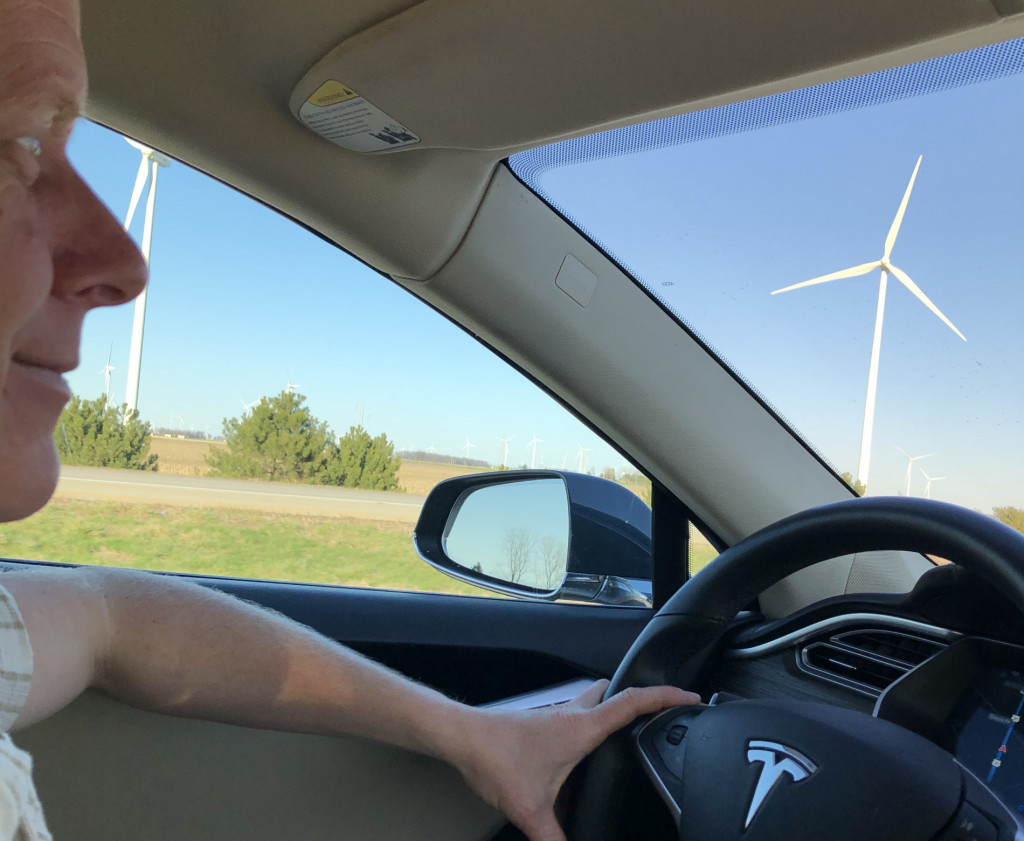
3. While we’re talking about electricity, do you know where yours comes from? Electricity in the US is generated, on average, from the following resources (all of the following info is from US Energy Information Administration (EIA) which has a lot of great resources if you want to learn more):
- 40% natural gas
- 19% coal
- 20% nuclear
- 20% renewables (like wind, solar, and hydro)
- 1% petroleum
If you want to get more specific to your state or electrical grid, you can learn more here (it’s another great page on the EIA website). Learning more about electricity is great, but my recommended action here is to call your electric utility company and request 100% renewable electricity. Most utilities have a program that lets you pay a little extra (for reference, my monthly bill increased $10 when I made the switch) for 100% renewable electricity. I know… you have lots of questions… like “how can I just buy renewables? Am I actually getting renewable electricity delivered to my house???”
The short answer is this: when you subscribe to green electricity programs like this you’re incentivizing your local utility to invest in more renewable electricity projects. This means they’ll build more solar arrays or install more wind turbines. You’re really buying a renewable electricity credits, which means that an equal amount of “extra” green electricity is being produced on your behalf. No, the utility can’t send this electricity directly to your house, but you are part of the overall move to a greener and more renewable electricity grid and you are voting with your dollars every single month. Still have questions? Drop them in the comments below and I’ll help you find the answer!
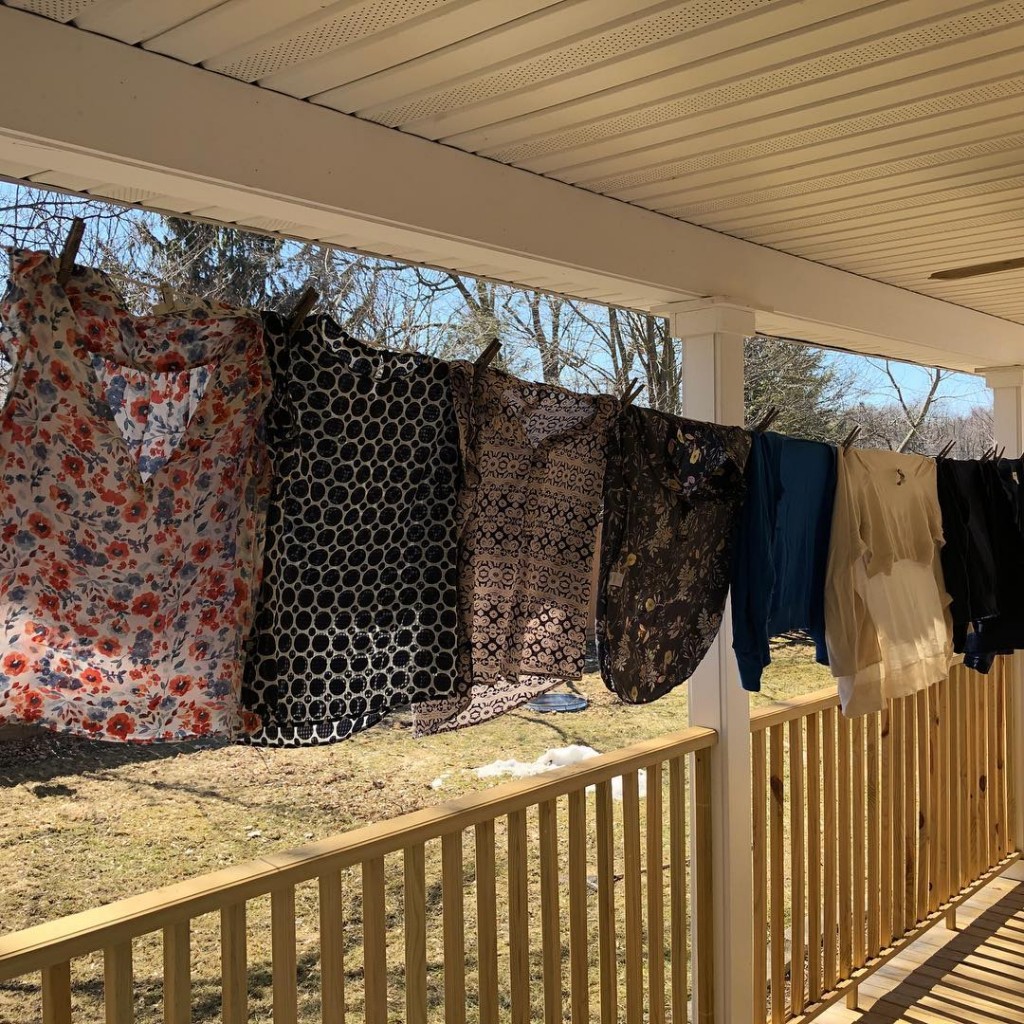
4. Embrace minimalism. Do you really need all the stuff in your life? Does it really make you happier? For me, minimalism is a great mindset to truly embrace the Reduce in the decades old mantra “Reduce. Reuse. Recycle.” Yes, recycling is important and you should do that too, but moving beyond recycling and buying less stuff is where the magic happens when trying not to destroy the planet.
Think about it this way: every single thing you own was created from the Earth’s precious resources. These resources were mined, grown or harvested from somewhere, transported to a processing site where they were turned from the raw material into a more usable form, transported to another manufacturing site where they were combined into the thing in your hands, transported to a store or warehouse, and then transported again to you. And that’s probably an oversimplified version of the truth. This happens over and over again for every single object in our lives. With this in mind, I ask again… Do you really need all the stuff in your life? What could you choose to live without? What would actually make you happier NOT to own?
If you’re ready to embrace minimalism, there are TONS of resources out there for you to explore, but some of my favorites include: The Minimalists blog, the book Soulful Simplicity by Courtney Carver, and the Our Minimalist Lifestyle Facebook Group. Please share your favorite resources in the comments!

5. Stop wasting food. Each year, the average American throws away more than 200 pounds of food at a cost of more than $1,600 per family! And if food waste were a country, it would be the third largest emitter of greenhouse gases (GHGs, the major cause of climate change), behind the Unites States and China. Farming of meat animals and food transportation are additional contributors of GHG emissions, so I’ll give bonus points for eating less meat and more local food.
There are lots of great strategies you can use to reduce food waste in your home. Some of my favorites include
- create a weekly meal plan
- buy less during each trip to the grocery store
- organize your food storage areas (fridge, pantry, freezer) so you can find your food easier
- learn about best by, use by, and other perishable food labels to avoid spoilage
- freeze leftovers and other perishable items before their expiration date
Here they are, all together once more:
- Drive less, walk and bike more
- Buy the most efficient car you can afford
- Buy renewable electricity
- Embrace minimalism
- Stop wasting food
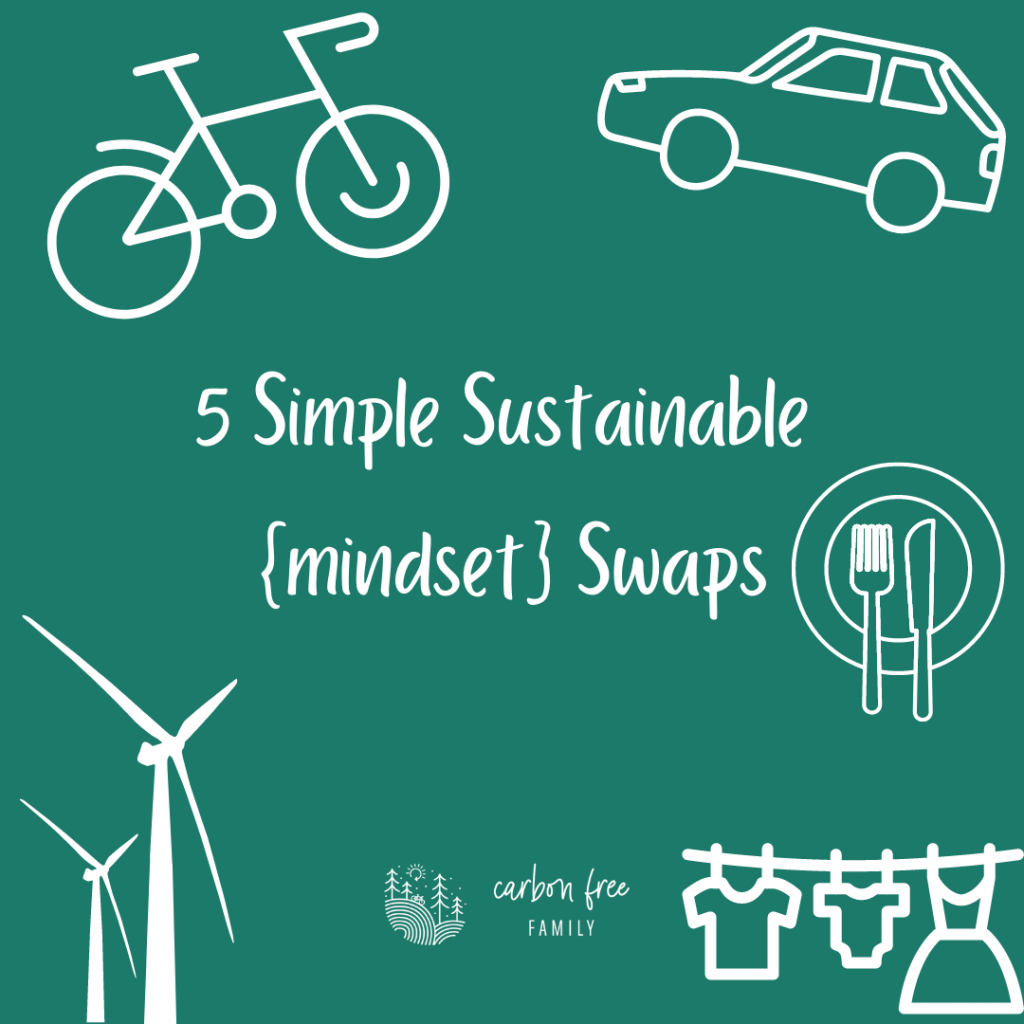
Do some or all of these recommended {mindset} swaps resonate with you? Share your thoughts and experiences in the comments!
Looking for more? If you’ve already made these swaps and are ready to make deeper change, I highly recommend calculating your ecological footprint and using the results to identify your biggest opportunities.
]]>
I should start by telling you that our daily life is not designed around a car, not any car. I bike my 1.6 mile commute to work, every single day (yes, even in winter… just for fun, I’ve included a photo of my winter bike below). And Robbie stays home with the kids so he doesn’t have a daily commute to work. Our oldest daughter walks to school. Robbie and our youngest daughter have designed their daily life around walkable and bikeable destinations. I’m forever grateful for the fantastic walkability and bikeability of our sweet little town of Rockford, MI. We drive 20 minutes for groceries (not more than once per week) and about an hour to visit close family + friends (again, not more than once per week). So our routine car use is pretty much a perfect fit for an electric vehicle.
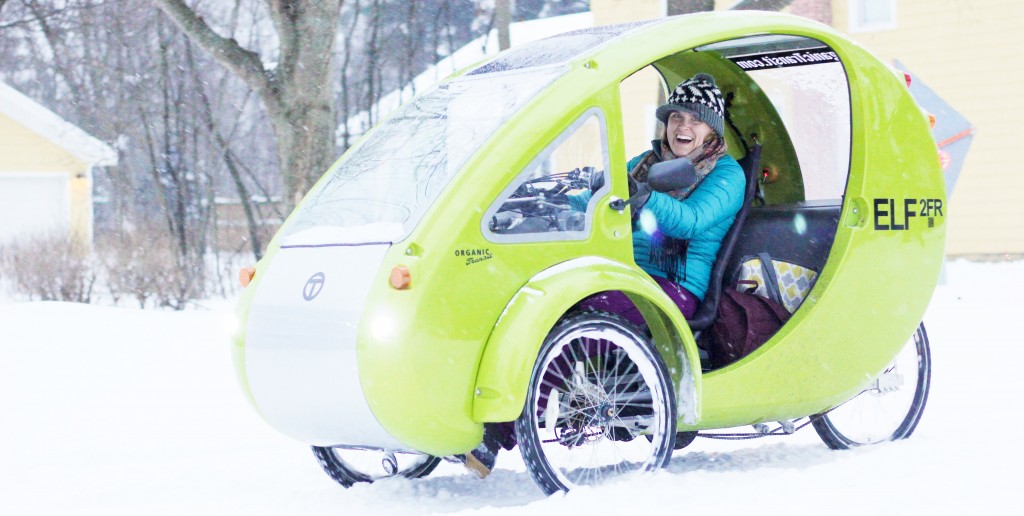
Let’s pivot to our Big Concern. Road trips. Full disclosure: I’m the worst roadtripper. Ever. More than a few hours and I turn into a whiny puddle of jelly in the front seat, asking “are we there yet?” more often than the children! So while this was our biggest concern, it still wasn’t that big of a deal because we usually fly somewhere far away or focus on finding adventure relatively close to home. Fast forward a few months after we bought the car… and here we are in the middle of a global pandemic and nobody’s flying, nowhere fast.
So, Spring Break 2021 was a family road trip to the Smoky Mountains National Park. We had a few major goals for this road trip:
- Drive the approximately 700 miles to our spring break destination
- HAVE FUN! (if you’re new to Carbon Free Family, you’ll quickly learn that this is always our top priority. We firmly believe that a more sustainable life can be fun!)
- Become more comfortable with charging our car while driving longer distances
- Arrive at our destination at or near the perfect check-in time at our AirBnB
We planned to take 2 days to drive the 700 miles from Rockford, Michigan to Hot Springs, NC and this trip went remarkably according to plan. The only planning I did ahead of time was to book our overnight hotel in Cincinnati. I picked the hotel specifically because they had two Tesla destination charging stations (I explain the difference between a supercharger and a destination charger in this FAQ blog). I was very pleased to learn that Marriott hotels lists electric charging stations in the “parking and transit” section of their hotel descriptions. I wish the brand would go one step further and include this in the “filters” so I can search specifically for hotels with charging stations (nudge, nudge @Marriott).

Away we go! Here’s what our first day looked like:
(you can follow along as if this were in real time in the “tesla EV” highlight on my Instagram)
2:15pm: Rockford, MI
We left the house at around 2:15pm with an 80% charge (237 miles). We weren’t at 100% because my daughter and I drove to our horse barn in the morning to sneak in a quick lesson before leaving for vacation. Ideally, we would leave the house with a full charge for a road trip like this, but life is all about compromise, right?
3:45pm:
We stopped for a potty break at 3:45pm. We didn’t need to charge yet, but… little bladders couldn’t hold it for 30 minutes to make it to the supercharger. Someday soon I’m certain there will be a EV charging station at every rest area and even our 15 minute potty break would recharge our battery a smidge.
4:30pm: Angola, MI
We stopped for our first charge of the trip in Angola, IN. We had about 55 miles of range left, so it was a pretty long charge. This was not my favorite charging station of the trip… slow speeds (only about 190 mi/hr or 55kW) and almost no amenities. Especially since we needed a big charge, I would have preferred a faster speed charger (you’ll see that sometimes we can get up to 400 miles/hour… this measurement is telling you the number of miles of charge gained by the battery per hour of charging). We stayed for about 45 minutes and left with 182 miles of range.
We like to plan our meals around charging stops, either popping into a grocery store to buy picnic supplies or ordering takeout from a nearby restaurant. In Angola, the charging station (a bank of 6 units) was located in an isolated strip mall with a motel and really small diner style restaurant. Maybe another time we’ll try the food, but this time we opted for soccer in the beautiful green space nearby. I would rate this stop 1/10 on speed and amenities, but 10/10 on green space. Check out the beautiful trail and field to play in!
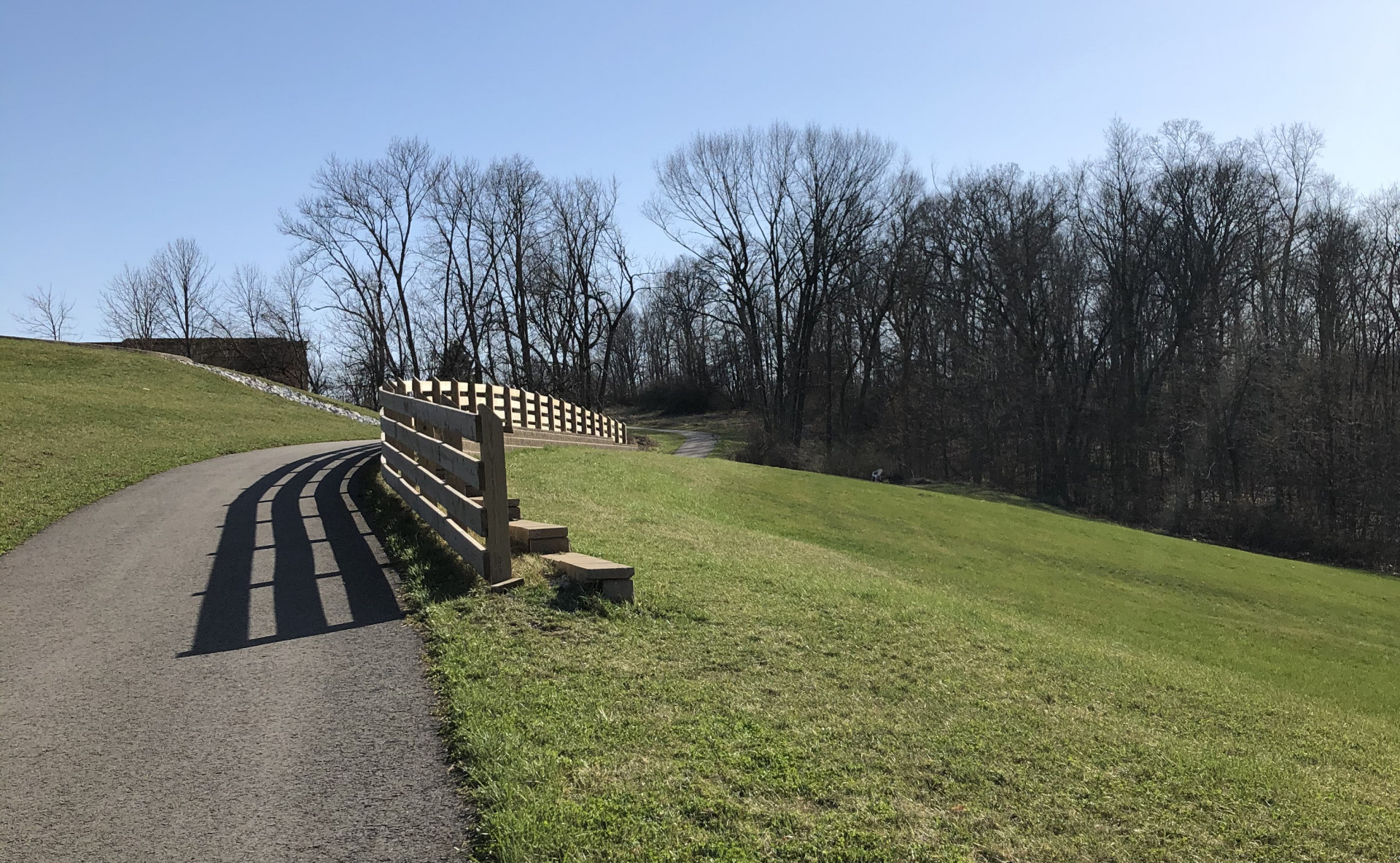
7:30pm: Lima, OH
We arrived with about 60 miles of range and were excited to find 8 spaces, only one other car, and fast charging speeds (between 320 and 350 mi/hr). This station was located in a very commercial area, with several hotels, restaurants, and not much green space. We walked through parking lots (no sidewalks… I should probably save it for another time, but I think there’s a real opportunity for areas near a charging station to be better designed for walkability) to a Panera Bread for snacks (for the kids) and a {decaf} cappuccino (for me) and to stretch our legs. Robbie played soccer with the kids in the hotel parking lot as the sun began to set. It was really a lovely scene. We stayed just long enough to gain enough charge to complete the remaining 135 miles to the hotel, around 40 minutes.
10:30pm: Cincinnati, OH
We arrived at our hotel happy and ready for bed. It took us just over 8 hours to drive 385 miles on the first day of our road trip. This is probably about an hour and a half longer than if we were death marching (meaning nascar style pee breaks with no time for play) in a gas-powered car. We don’t travel that way anyways, so for us this feels like slightly longer than it would have taken us in our old {gas-powered} car, but not noticeably longer.
We stayed at a Marriott and they had two Tesla charging stations + another non-tesla charger. The charging speed was slow (about 25 miles per hour), but slower speeds are fine for an overnight stop. We left in the morning around 9am with a full charge (251 miles… even more than when we left our house the previous day!).
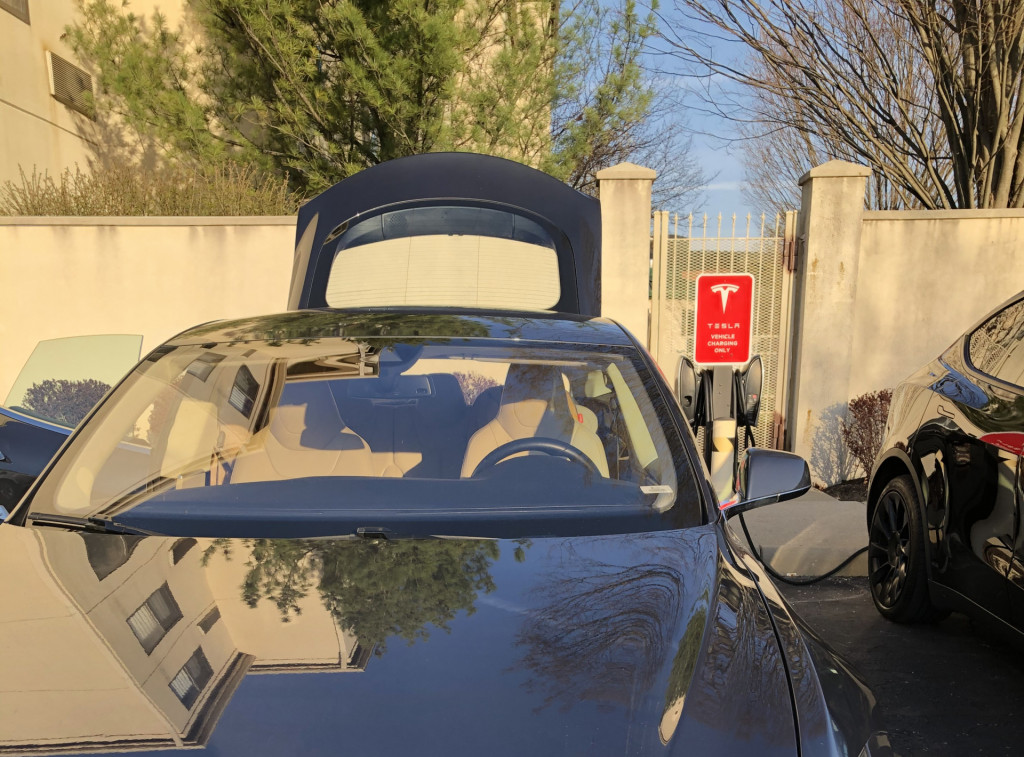
And we’re off again! Day 2 of our road trip:
9am: Cincinnati, OH
We only had 295 miles to go today and planned on making just one charging stop. We couldn’t check into our AirBnB until 3pm, so we took out time leaving the hotel.
11am: London, KY
This was the best charging stop of our trip! We knew we wanted to eat an early lunch, so I went online on my phone (from the highway) to look for a restaurant. There was a Cracker Barrel nearby so I placed an order online. Once we arrived, I took a nice little walk (again, no sidewalks though) to pick up our lunch while Robbie and the girls played soccer + set up a beautiful picnic space. This charging station had it all… green space to play, easily accessible bathrooms (in a tourist information center) and lots of restaurants to choose from. We took our time here and stayed about an hour, plenty of time for our car to completely charge up again.
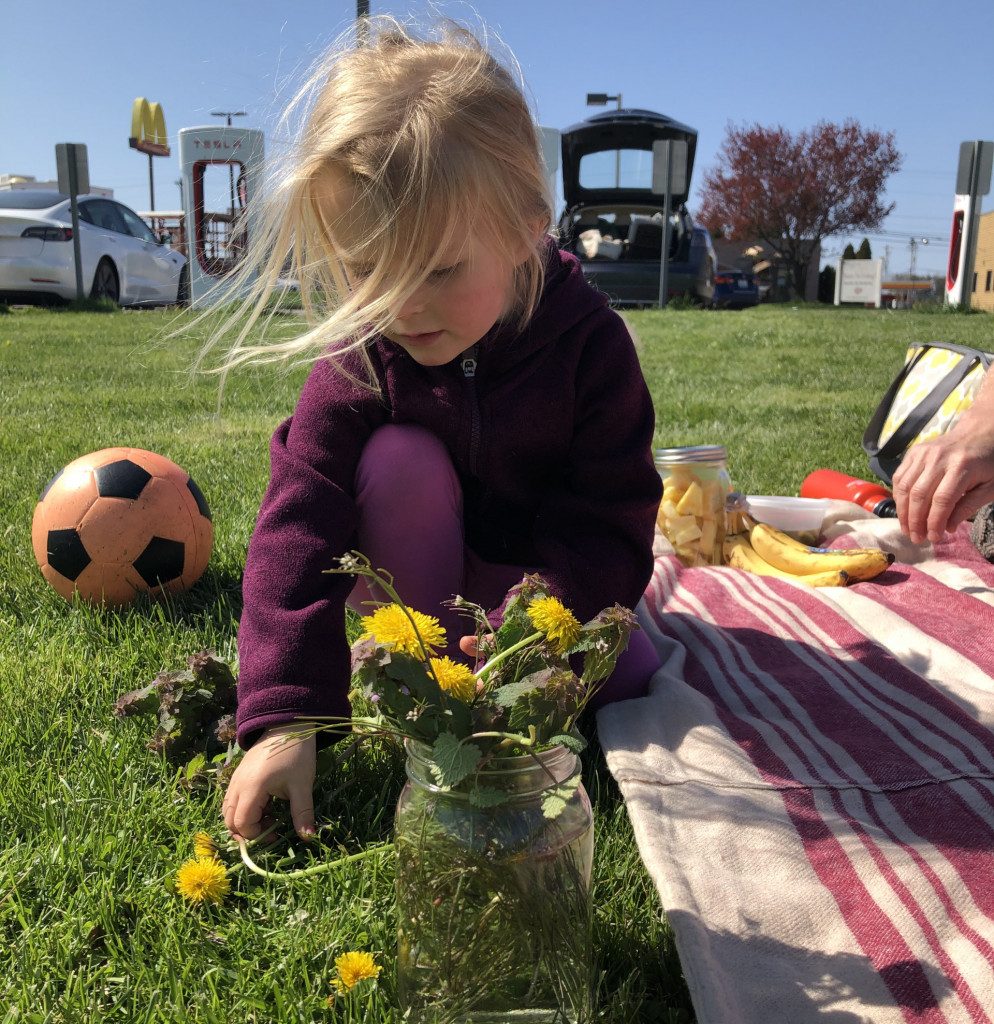
3pm: Hot Springs, NC
We arrived! Happy, healthy, relaxed, with plenty of charge left, and ready for a wonderful week in the North Carolina mountains!
But what about during vacation… I’ll admit that I didn’t really think about this when booking my family vacation in a tiny little town in the North Carolina mountains. We didn’t even ponder how we were going to recharge during the week until it magically popped into Robbie’s head a couple of days before we left. Thankfully, there was a charger in downtown Hot Springs, less than a half mile walk (on the Appalachian Trail, no less) from our rented home. Twice during the week, we used these charging stations at the Hot Springs Resort and Spa (and campground). These were destination chargers (again, see this FAQ blog for a full explanation of what this means) so they charged slowly, but we parked there overnight and it worked out just fine.
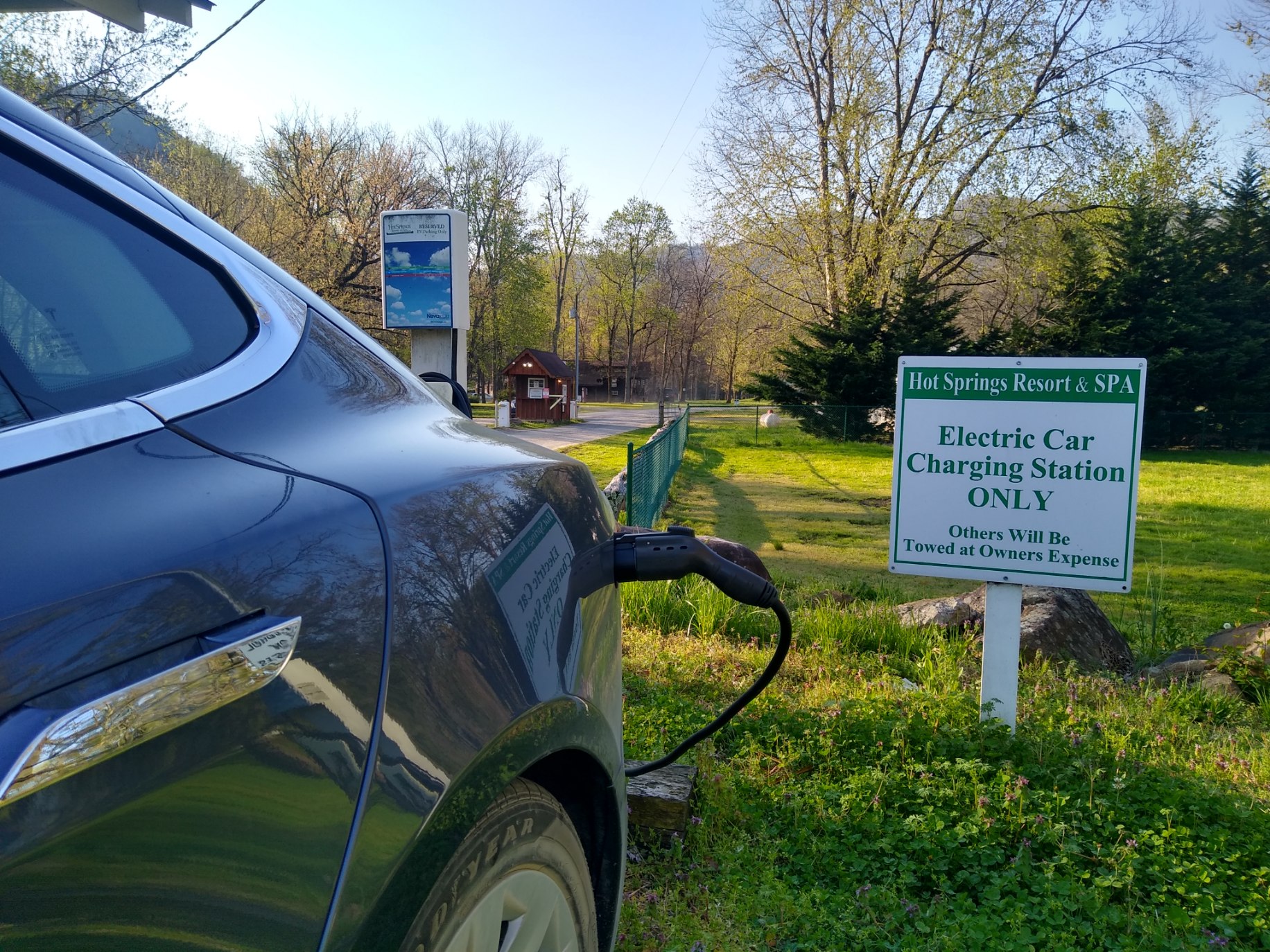
So what were my key takeaways from this first road trip in my new Tesla?
- It doesn’t take that much longer. In fact, pausing to recharge my car supports my intention to live a slower life. It encourages me to enjoy the little moments along the journey rather than racing to the destination.
- Plan ahead for food. Ordering on the road and having snacks in cases where food options are limited are both helpful strategies.
- Make sure there’s a charger at/near your vacation destination
Are you driving an electric car yet? If so, tell me about your charging adventures in the comments! If not, whats your biggest concern… what’s holding you back?
]]>
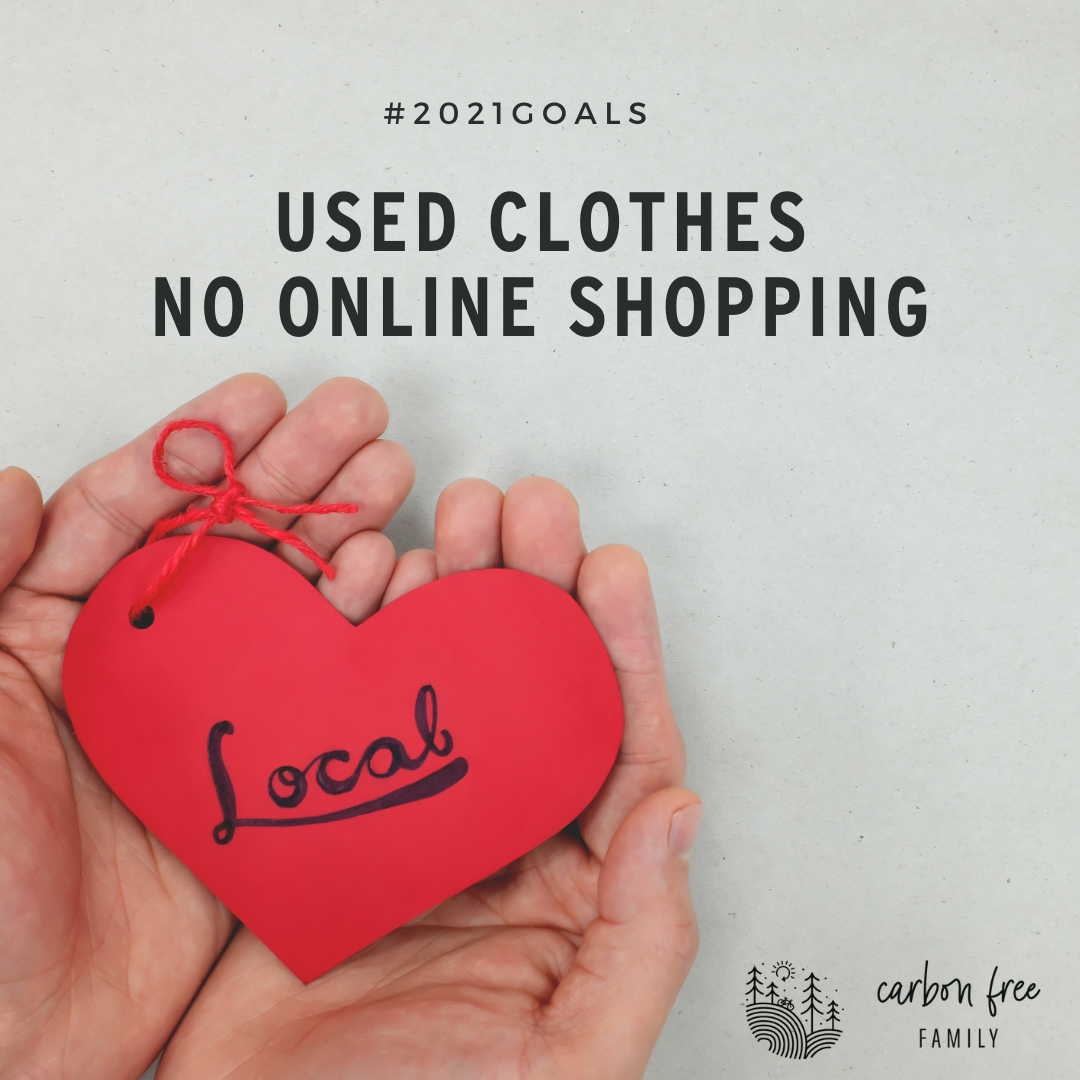
According to the calculator, my goods footprint is pretty much nonexistent, but I firmly believe there’s always room for improvement. The goods category includes all the “stuff” in our lives… clothes, kitchen gadgets, books, magazines, home decor, basically anything you buy thats’s not food.
I’ve spent the last few years really focused on not buying stuff I don’t need. Call it minimalism. Call it sustainability. Call it slow living (because in retrospect, I’m shocked at how much time and energy I used to spend shopping). Whatever you want to call it, it makes me happy.
- Buy used clothes. So one of my goals is to simply keep up the good habits I’ve worked so hard to create. Not to let culture sway me back into habits that don’t serve me well. In 2020, I didn’t buy any new clothes (only used, and in full disclosure I did buy myself a new bra after my old one broke and my amazing mother bought me new undies and socks as gifts). I promise to post more about my capsule wardrobe strategies and the wide-ranging benefits of buying used in an upcoming blog post, so if you have specific questions, please drop them in the comments below!
- No online shopping. This year, I’m adding a second shopping related goal: to only buy {clothes + everything else} from local stores. I’m excited to put my dollars into my community and the individual people who own/run small businesses here. Sure, I might have to get creative and/or wait a day or two longer to get something, but I think creativity and patience are two GREAT skills to cultivate! This means I’m going to be asking for your advice (local friends, I’m looking at you here) for local places to buy the random things I need throughout the year.
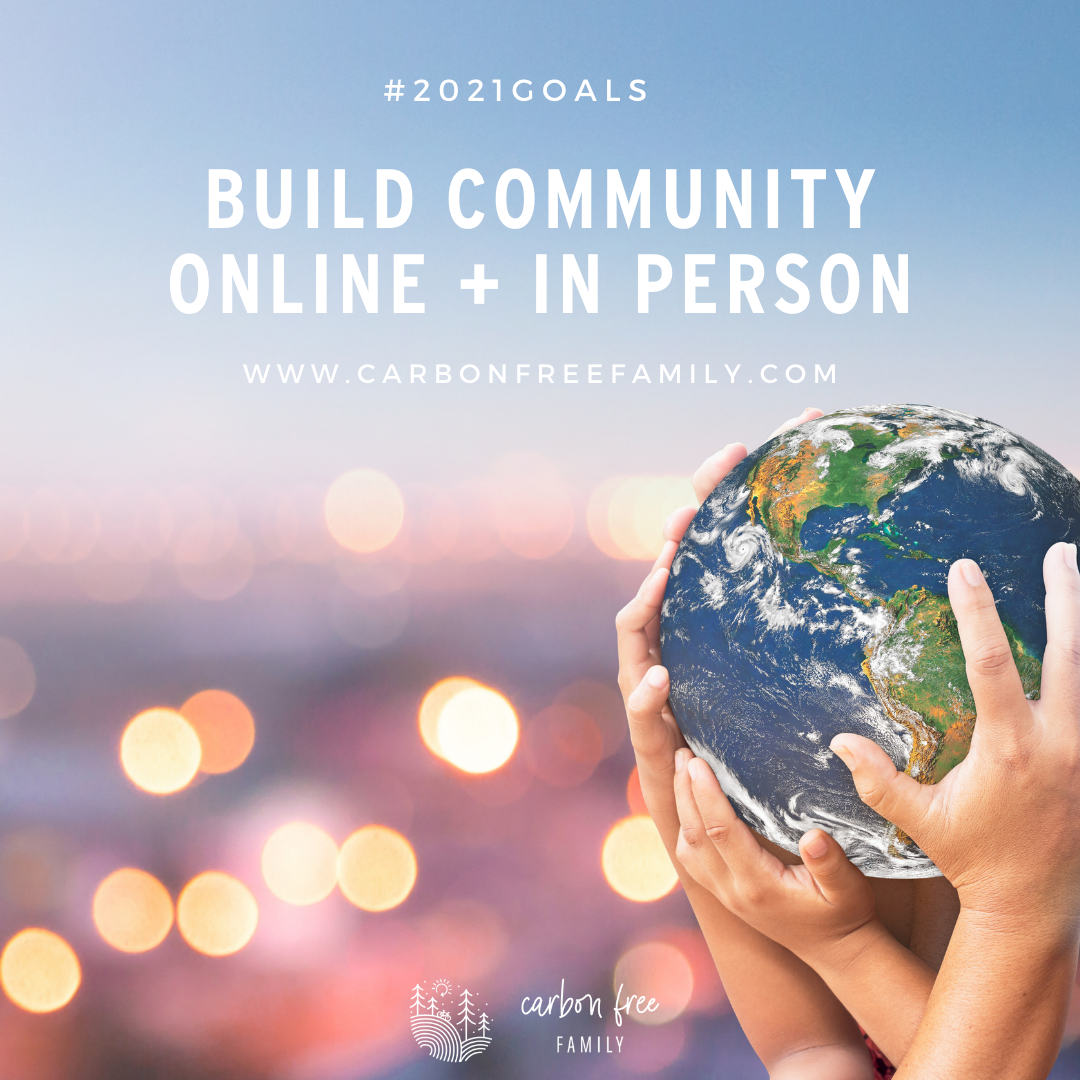
How do you influence your friends, family, community, and elected officials? It’s fine if the answer is “I’ve never really thought about that”; my space is always a judgement free zone. The last category of my eco-footprint is “services”. Services include all of the infrastructure (mostly government) that supports your life, but isn’t within your direct control (think, roads, train tracks, bridges, police, fire, etc). This category invites us to think about the ways we influence the world around us.
While the environmental impact of these are not directly controlled by my actions (at least not compared to the car I choose to drive or the food I choose to eat), I firmly believe that we can and should influence them. This right here is why I publicly talk about my sustainability journey. This is why @carbonfreefamily exists! When I started Carbon Free Family in 2018, my goals was to talk about the joy, laughter, fun, and calm I find in a more sustainable life and hope that my story helps you find more a more sustainable version of yourself and your life.
To continue my sharing journey in 2021 and support your personal sustainability growth, I’m excited to keep working to build this amazing community of people and resources, collectively committed to living a more sustainable life. I will be building more of these resources and community space:
- Digitally on Instagram, Facebook, and www.CarbonFreeFamily.com. Follow me on whichever is your preferred platform to stay in touch and involved!
- Through community presentations and workshops (online and someday soon in person again)
- In person gatherings, like the clothing swaps and mending parties I started hosting in early 2020. I can’t wait to gather with you again soon!
Sign up for my email list to get updates when a new blog post or event is posted!

Self care isn’t a category in the environmental footprint calculator, but self care is critically important for us all! We have to take care of ourselves before we can take care of the community and the planet. So, while this is the last set of goals I’m sharing with you, it might be the most important.
My early morning routine includes stretching, meditation, and coffee. I will continue to make quiet time with myself a priority. Every day.
2021 will be my third year participating in the 52 Hike Challenge (this is a great program with really great resources, especially for beginner hikers, so if you’re interested in learning more I highly recommend following to link to their website). My weekly time in nature continues to bring me such joy, connectedness (with nature and the humans that come along), and health. This year, as a bit of an added challenge, I’m going to try to visit as many different trails/parks as possible. I’m not fully committing to 52 different trails (because I’m so very fortunate to live near the White Pine Trail and some days I just don’t want to drive anywhere), but I am excited in intentionally explore new pockets of nature.
2021 will be my second full year participating in the 52 Days Unplugged challenge (again, to learn more, please visit the link or look for the #52daysunplugged posts on my Instagram and Facebook). I still struggle to have a healthy relationship with my phone, but weekly phone free days have opened my eyes to the addiction (and I don’t use that word lightly). This year, I’m going to continue to have at least one screen free day per week. Additionally, I’m going to focus on bringing screen free moments into my daily life, working to use my phone with intention (vs mindless scrolling or addictive pickups) each day.
WHEW! Now that I’ve written it all down, that feels like a lot to work on in just one year. And I feel compelled to talk about giving ourselves grace when setting our goals and working on them throughout the year. My goals are mine; your goals are yours. Our goals won’t look the same, just like our lives don’t look exactly the same. We’re all at a different place in our personal sustainability journey. Some habits take longer to break than others (for example, it took me 3 whole years to fully build my bike to work habit. Seriously, three years of walking out into my garage each morning and talking myself into hopping on that bike instead of the car). Additionally, my goals are made up, they only exist to serve me, to make my life better. If mid-way through the year, I realize a goal isn’t serving me in the way I intended, I LET IT GO! I encourage you to give yourself the same grace and flexibility.
]]>
Let’s make a list of creative ways to “dispose” of your Christmas tree! Here are my favorite ideas. Please share yours in the comments at the bottom of this post.
- Put them in our yard to provide winter shelter for the birds and other small animals that live in your yard. This is a great option if you decorated with natural decorations or want to redecorate it for the animals! Birdseed ornaments, popcorn and cranberry garlands, and dried oranges are all great gifts for the animals that live in your yard. You can find lots of great ideas in this article from the US Fish and Wildlife Service.

- Donate them to a local farm… goats LOVE to eat pine and spruce trees! Local friends, if you’re interested in this option please email me or comment below. I know several farmers offering to take your Christmas trees off you’re hands… one is even willing to pick it up from your house!

- Compost them in your backyard compost.
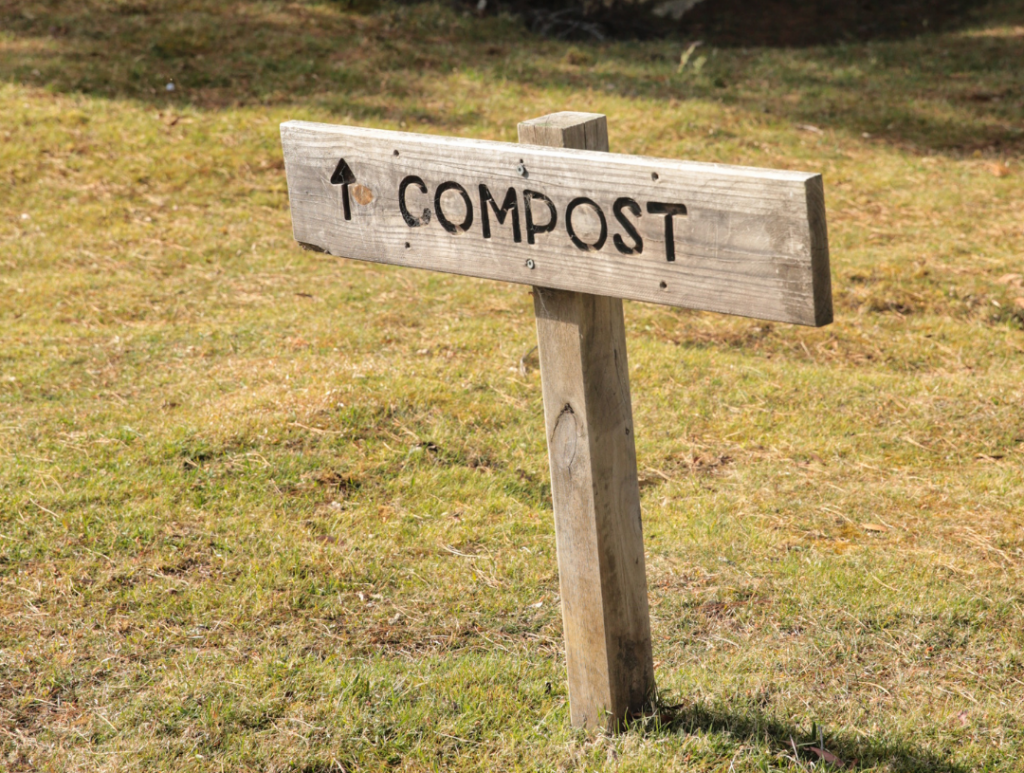
- Put them on the curb for pickup by your local municipality. Many towns and cities have specific days designated for Christmas tree pickup. Usually these trees get added to the municipal yard waste composting program.
- Drop them off at a location designated by your town or municipality. Again, these trees usually get added to the municipal yard waste composting program.

Rockford, Michigan friends: The City of Rockford offers curbside Christmas tree pickup for two weeks after Christmas. Pickup does not happen on a particular day, so go ahead and leave your tree on the curb whenever you’re done cleaning up (provided its before January 8th)
Kent County, Michigan friends: You can find a list of curbside pickup and drop off programs, listed by city/township, here.
Note that you need to remove all decorations before using any of the above alternative disposal methods. Please share your questions and alternative disposal ideas in the comments!
]]>Looking to build more sustainable habits in 2021? Please join my workshop… Kickstart Your Sustainability Journey! This 6-week online workshop will change the way you think about sustainability, flipping your mindset so that sustainability becomes a natural part of every decision you make and creating easy sustainable habits. Find more information and register here!
I also firmly believe that you are not obligated to keep gifts that do not bring you joy or support the life you are trying to live. This does not make you ungrateful. Yes, someone spent time and money choosing the gift for you, but they wouldn’t want you to compromise your values to keep something that doesn’t fit… your body, your lifestyle, or your values.

You can be grateful and still not keep every gift you receive.
We’re all trying to build the life we want to live. I’m focused on a simple life, built on minimalist and sustainable values. It is a core value that I do not keep things in my life that do not bring me joy. And in general, stuff does not bring me joy.
So what do I do when someone gives me a gift that doesn’t support my life? I pass it on to someone who will appreciate it and use it!
Interested in building more sustainable habits in 2021? Please join my upcoming virtual workshop: Kickstart Your Sustainability Journey!
Here are my simple strategies for passing on gifts:
- Exchange or return it.
I think this can be done in a way that honors both the gift giver and my values. It might be important to be honest with the gift giver if you go this route, but I trust that if you approach the conversation with love and kindness, you’ll leave even more connected to each other. This is an especially good strategy if the color or style doesn’t fit your life, but the gift comes from a store that has other things that would fit you better.
2. Regift it
I LOVE regifting things! It doesn’t have to be Christmas or their birthday, giving someone a gift on a non-holiday can be even more special! It’s worth noting that this is only a kindness if you truly believe the gift will be a blessing to someone else. Regifting at random just passes the clutter (or act of donating) on to someone else.
3. Donate it
There are plenty of people in need these days. The gifts that don’t quite fit you could be very helpful for someone who is stretching to make ends meet. Donate unwanted things (maybe as part of a January clean out? see below for more on this) to your local charity of choice or directly to an individual in your community using online groups like Buy Nothing group on Facebook
I can’t help but highlight the opportunity that’s just below the surface this time of year… the annual purge, clean out, or whatever you choose to call the opportunity to review your accumulated stuff to make sure it is still truly bringing value to your life. If not, pass it on!
After Christmas is an especially good time to do this with kids. If you’re new to this sort of activity, give yourself grace and time (it might take longer and more energy than you think, but I swear it’s worth it to surround yourself with only things that fit your life) and consider approaching only one area of your house at a time. And if you need help, ask for it! I’m happy to support you on this journey and can design a one-on-one coaching program to meet your specific needs. Send me an email (at carbonfreefamily@gmail.com) or complete this form to start discussing the possibilities.
Also worth highlighting in a little more detail is the growing number (and value) of groups like my local Buy Nothing group on Facebook. If you’ve never heard of a group like this, the basic premise is such: the group is a platform for giving away and asking for things you need with NO exchange of money (or any sort of value, trades usually aren’t allowed either). You can give away just about anything you want, including stuff, services (like offering to cook a meal for someone or teaching someone to mend their own clothes), or time (like offering to meet people for a coffee date or picnic). Alternatively, you can ask for the same types of things. I love this model because you’re giving things directly to a person who has 1) asked for them or 2) expressed a need, rather than potentially overwhelming a charity with unwanted stuff.
Getting to know your local Buy Nothing group is a great strategy to manage your stuff throughout the year. I’m constantly giving things away using this group and asking for things you need. I always feel like I should give more than I take from groups like this, but they’re an amazing resource to ask for things you need too! Last summer, I picked up kefir starter and used roller skates for both my kids from my Buy Nothing group… for free!
Comment with your questions and additional recommendations below!
]]>Please join my upcoming workshop… Kickstart Your Sustainability Journey! This 6-week online workshop will change the way you think about sustainability, flipping your mindset so that sustainability becomes a natural part of every decision you make and creating easy sustainable habits. Find more information and register here!
